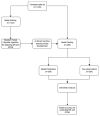Evaluation of Systemic Risk Factors in Patients with Diabetes Mellitus for Detecting Diabetic Retinopathy with Random Forest Classification Model
- PMID: 39202252
- PMCID: PMC11353512
- DOI: 10.3390/diagnostics14161765
Evaluation of Systemic Risk Factors in Patients with Diabetes Mellitus for Detecting Diabetic Retinopathy with Random Forest Classification Model
Abstract
Background: This study aims to assess systemic risk factors in diabetes mellitus (DM) patients and predict diabetic retinopathy (DR) using a Random Forest (RF) classification model.
Methods: We included DM patients presenting to the retina clinic for first-time DR screening. Data on age, gender, diabetes type, treatment history, DM control status, family history, pregnancy history, and systemic comorbidities were collected. DR and sight-threatening DR (STDR) were diagnosed via a dilated fundus examination. The dataset was split 80:20 into training and testing sets. The RF model was trained to detect DR and STDR separately, and its performance was evaluated using misclassification rates, sensitivity, and specificity.
Results: Data from 1416 DM patients were analyzed. The RF model was trained on 1132 (80%) patients. The misclassification rates were 0% for DR and ~20% for STDR in the training set. External testing on 284 (20%) patients showed 100% accuracy, sensitivity, and specificity for DR detection. For STDR, the model achieved 76% (95% CI-70.7%-80.7%) accuracy, 53% (95% CI-39.2%-66.6%) sensitivity, and 80% (95% CI-74.6%-84.7%) specificity.
Conclusions: The RF model effectively predicts DR in DM patients using systemic risk factors, potentially reducing unnecessary referrals for DR screening. However, further validation with diverse datasets is necessary to establish its reliability for clinical use.
Keywords: diabetes; diabetic retinopathy; new cases; random forest classifier; screening.
Conflict of interest statement
The authors declare no conflicts of interest.
Figures
References
-
- International Diabetes Federation IDF Diabetes Atlas [Internet] 2021. [(accessed on 15 November 2023)]. Available online: https://diabetesatlas.org/#:~:text=diabetes%20around%20the%20world%20in%....
-
- Magliano D., Boyko IDF Diabetes Atlas 10th Edition Scientific Committee IDF DIABETES ATLAS [Internet]. 10th Edition. Brussels: International Diabetes Federation; 2021. Table 3.4, Top 10 Countries or Territories for Number of Adults (20–79 Years) with Diabetes in 2021 and 2045. [(accessed on 15 May 2024)]. Available online: https://diabetesatlas.org/resources/?gad_source=1&gclid=Cj0KCQjw5ea1BhC6....
LinkOut - more resources
Full Text Sources


